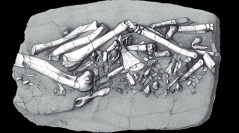

 Geodiversitas
36 (4) - Pages 623-667
Geodiversitas
36 (4) - Pages 623-667The collection of fossil vertebrates from Luberon on the one hand, and the description of the fossil animals from “Mont Léberon” by Gaudry, Fischer & Tournouër in 1873 on the other, played a major role in the emergence in France of what can be called evolutionary palaeontology. Gaudry decided to excavate the locality of Luberon (also called Cucuron) to compare its fauna to that of Pikermi described by him a few years before. In the section of the monograph devoted to vertebrates, Gaudry especially developed the biostratigraphical, paleobiogeographical, and evolutionary aspects of the fauna in a very modern manner. From the evolutionary viewpoint, Gaudry discussed the question of identifying chronological and/or geographical “races”, that is subspecies, and species.
This genuine work is mainly based on the collection housed in the Muséum national d’Histoire naturelle, Paris (MNHN), so that both the monograph and the collection are milestones in the history of palaeontology. The fate of the collection since Gaudry’s time is analyzed from the curators’ viewpoint. The previous state of the fossils is described as well their restoration.
The fossils were previously disseminated in several areas of the palaeontology building due to their different sizes. They are now located in one place opened for study and revision (a few is exhibited in the public gallery). The basic cleaning and restoration of the material was also associated with the taxonomic and geographic identification since several specimens studied by Gaudry had been in the past erroneously transferred to other localities such as Maragheh (Iran). One explanation, except previous poor curation, is the greyish colour due to dust, decades after decades, that makes the different late Miocene fossils of various localities look alike (and even from middle Miocene). One example is one exquisite cranium of Gazella deperdita (now MNHN.F.LUB681) figured by Gaudry in his monograph dated 1873, which bore other undue numbers with the MAR acronym for Maragheh (Maragha in the French litterature), and previously thought to be lost.
Once cleaned, the specimens were restored and consolidated with an acrylic emulsion (a methyl methacrylate/n-butyl methacrylate polymer), with different concentrations depending on different operations. Generally speaking the collection was in a very bad state and numerous specimens figured by Gaudry broken and incomplete since their description. The worst case is a specimen broken in seven parts. As an example, let us cite one tibia-fibula of the rhinocerotid Dihoplus schleiermacheri figured by Gaudry was found in six pieces, some of them discovered in a drawer containing miscellaneous middle and late Miocene mammal fragments. Others were not even completely separated from the matrix, a situation not always demonstrated by Gaudry’s drawings which are sometimes more reconstructions then mere reproduction. Ultraviolet light was used to identify old hand writing. Many fossils of Gaudry’s collection from Luberon bore the number 156, but not all. This number corresponds to the first catalogue number of Gaudry’s collection. Other specimens from Luberon are from Christol, Caire, Conil, Lartet, Saporta and Depéret’s collections (some Saporta’s specimen bore also Gaudry’s number 156). All the collection is now labelled with the acronym LUB for Luberon, that is, 988 numbers for 1201 elements. The electronic catalogue is complete and available online at the address: http://science.mnhn.fr/institution/mnhn/collection/f/item/search/form/
For the first time since 1873, the entire set housed in the collection of palaeontology is available. Although a rather modest collection, its expertise, restoration, and electronic catalogue were time consuming. Circa 700 hours were spent during the last two years on the curation of the material from Luberon. This timing gives an idea of what is needed for the whole collection of fossil mammals (between 300 000 and 500 000 specimens). Yet, as it is, the Luberon collection is ready for the next century, and after (as the other fossil mammal Late Miocene localities). More generally speaking, restorations of specimens such as these from Luberon, are the basis of curation in palaeontology and, ironically, are in contradiction with present strategies of collection managing which favour data banks somehow disconnected from the specimens themselves.
Albert Gaudry, Mammalia, Miocene, Luberon, Collection, Curation, Palaeontology.